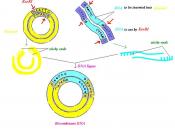. Genetic engineering involves the alteration of an organism s hereditary material in order to eliminate undesirable characteristics or to produce plants with more desirable characteristics. The splicing of genes takes place in order to combine traits that would be unlikely to occur together under ordinary circumstances. Practices that go back centuries, such as the use of microbes to make wine and cheese and the selective breeding of livestock and crops, are example of biotechnology . (Campbell, 1999) These, and other, procedures have relied on mutation and genetic recombination. Biotechnology that is based on manipulation of DNA is different from earlier practices because it enables scientists to modify specific genes and move them from organisms as distinct as bacteria, plants, and animals. The actual splicing of genes into foreign genomes is very complex. Many varieties of full-grown adult plants can regenerate from single, modified plant cells called protoplasts plant cells whose cell walls have been removed by enzymatic digestion.
(Peters) Plats that can be cloned easily include carrots, tomatoes, potatoes, petunias, and cabbage. Being able to grow a whole new plant from one cell means that researchers can engage in the genetic manipulation of the cell, let the cell develop into a complete plant and examine the physical and growth effects of the genetic manipulation within a short period of time. The results of genetic engineering in plants are easier to examine than the same process in animal cells. A new technique known as recombinant DNA, or gene splicing, will allow scientists to alter an organism s genes directly by joining its DNA to the DNA of a second organism. The result is recombinant DNA that permanently changes the genetic makeup of the organism and alters the proteins that its cells produce. This change will then be passed on...


